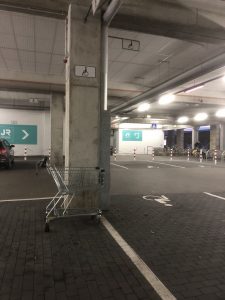Necessary Paradoxes – Shopping Carts of Humanity
Some things function at their best when they disappear. They are meant to be there - to make life a bit easier, to be used without us really realizing it. They fade into the background, but are indispensable to our experience of modern life. Yet, they only appear when they suddenly cease to exist - they are necessary paradoxes; objects that are necessary in everyday life, but, paradoxically, only remind us of their existence once they're gone. In this series, these objects are exported out of obscurity - because in examining the lives of these things - how we treat, use, produce, discard them (and how, in a way, they do the same to us) - we might be rewarded with unexpected insights into our own lives.

Transport is obsession. But then again, dragging your own body is just, oh, so exhausting. Hence, we are obsessed with getting from one place to another while using our feet as little as possible. From horses to carriages, bikes, cars, ships, planes and even spaceships – these means of transportation are holy to us. Your uncle’s love for trains, your friend with the bike shop and the always oily fingers, the president of Turkmenistan, Gurbanguly Mälikgulyýewiç Berdimuhamedow and his hilarious (and a little uncomfortable) infatuation for horses – at their core, they all celebrate transportation. Means of transportation are often symbols of status; kids barely able to walk will boast about their new bike just as much as statesmen about their new rocket ship. But we do forget about some, and one in particular should be more revered than it is. Time for a joyride.
By Nathan Hümpfner.
For a minute, my heart stops—at this speed, I could cause some serious damage. This sport is no joke, 24000 kids are injured every year speeding like this. I take a sharp turn just in time; my whole body is whipped around – I can hardly hold on – while my legs are trying to get a grip. I feel the wind in my hair and a feeling of overwhelming freedom overcomes me until I pass the breakfast section and have to stop for some cereal and some cheese.
The vehicle we have all used for these kinds of races lurk on seemingly every street corner, but definitely in every supermarket, sometimes littered with old receipts, other times with a clunky, wobbly wheel that will make it drift as well as hard to jump onto and enjoy the ride—the universal symbol of all things consumerism: The shopping cart. These joyrides, just like the shopping cart, are an indication of what is needed to have carts in the first places—space and money.
Vehicles of prejudice
But hold on, let’s start from the beginning: The shopping cart was invented by Sylvan Goldman and first introduced in his Humpty Dumpty supermarket chain on June 4, 1937. Initially conceived to help women deal with the apparently terrifying combination of carrying a basket and caring for their children, it was met with mixed reviews, because, among other reasons, men thought of it as, well, „too feminine“ and women found it to be suggestive of a baby stroller. So, how do you get people to overcome their strange and sexist prejudice? That’s right, counter prejudice with prejudice – just introduce beautiful humans. Besides hiring clerks who would explain the cart’s usage, Goldman started employing models who would push the cart around mindlessly, never actually buying anything. But: this turned the shopping cart into an immediate success.
Right from the get-go, these bulky metal baskets on wheels said something about the people using them, their prejudice, desires and daily realities. Once you put things in your cart, you not only serve as a walking advertisement of the brands in your see-through cart, you also showcase who you are; what you eat, wear, use; if you have to feed a family of six or just your six cats; how healthy you live or what your cultural background is. This data is, as you surely know, fully taken advantage of in any way possible (if you wondered what these cashback-programs are for, there you go).
Sound and vision

But not just what you put in your shopping cart says something about you, where you use it is also a symbol of your status. The image of the cart changes drastically once you leave the premises of any grocery store. Approximately 100,000 (of six million) carts are lost each year in Germany alone and mostly end up in ditches or turned over on the side of the road—or, as one article hilariously suggests, are used a lot for grilling or as a „cool“ accessory for apartments shared by students. While these extended loans hardly ever warrant legal repercussions, they cost German supermarkets a few million dollars each year (as a shopping cart’s retail price is about 150-200€). Hence, they hire people to retrieve them, and they do so often from people who need them.
Those people who need shopping carts on a daily basis are those who do not just cram their food into the metal baskets, they transport their whole identity in a cart: the homeless. Again, the where and what of the shopping cart dictates a lot about what we think about the person pushing said cart. If you don’t use the object in its usual habitat, then what are you using it for? In the head-spinning documentary Carts of Darkness, the cart serves another purpose for those living alternative lifestyles: it is the absolute center of their lives, a trifecta of unrenounceable work-vehicle, compressor of space-time (as in: it takes less time to cross over from spot a to spot b) and injector of vitality, as they cruise downhill on their carts at breakneck speed (up to 70Km/h) to pick up empty bottles that can be converted into money. Sadly – or fortunately – as these carts are of a different design all around the world, this is not possible with German carts. I’ve tried it, believe you me.
A different litmus test
But shopping carts do not only tell you what your social status is and where you live, but also, apparently, whether you are a good person. Consider this: if shopping carts would not require your precious 50 cent coins, would you return it after a long, arduous shopping trip? Seeing as you get nothing from returning it, the labor of returning the cart remains unrewarded. Most of the time you won’t get to see the „damage“ you’ve done by just abandoning these poor metal wires, and even if there was a clerk to pick it up right away, wouldn’t it be his job? Fringe voices say this might even help in keeping those jobs alive. The shopping cart theory is a mildly serious psychological test: how good of a human being are you? Are you an altruistic person? Are you willing to do a good thing without a reward? Or do you let other people fix your mess? What excuses can you come up with to defend not returning your cart?
Once, ten years ago, I moved by shopping cart. I was too poor and new to the city (i.e. friendless) to move any other way. I vividly remember trying to heave my crisp mattress into a shopping cart to move from Kreuzberg to Neukölln (it didn’t fit and would later fall flat into what I remember to be an almost indescribable and just slightly snow-ish substance) and then pushing the damn trolley all the way to my new place. All my belongings rattling about. The noise you involuntarily produce ‚rolling‘ over cobblestones marks you as someone inconsiderate. It felt funny and yet, I was embarrassed. I felt a certain stigma; my whole personality, my inability to afford a moving company or even just a car was on display, and everybody heard it coming from miles away. The rush I felt when I finally arrived at my new place, at the certainty of a private home, was exhilarating.
That day, I did not return the shopping cart.






